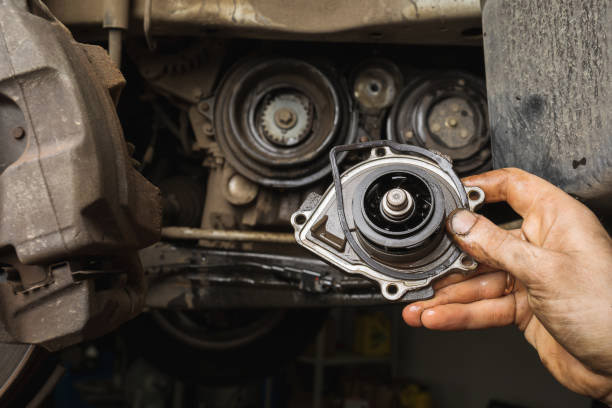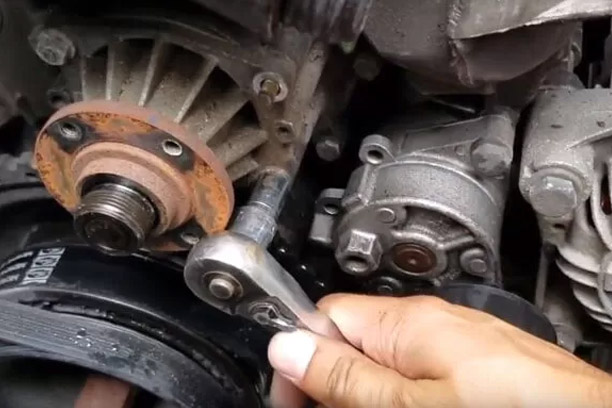The Importance of Water Pumps

Water pumps are a vital part of your vehicle's engine. Although they may not seem to have an essential role in the overall function of your vehicle, they are a critical component that helps keep your engine running smoothly and efficiently. Without them, you would never be able to cool down your motor and prevent it from overheating.
Water pumps can fail for many reasons, so it's essential to understand how they work and what signs indicate it's time for a replacement.
What Does a Water Pump Do?
The water pump is a part of your vehicle's cooling system. It pumps coolant through the engine, carrying heat away from vital components like the cylinder head and pistons. The coolant then travels to the radiator, where air cools it before returning to the engine as warm liquid.
The water pump has an impeller (a rotating blade) that spins at high speed when you turn on your vehicle's ignition. As this impeller turns, it forces liquid out through small holes in its housing onto one side of its rotational axis. This action creates a centrifugal force that pushes more fluid toward those same holes on their opposite sides.
This causes both ends of each chamber within this assembly space (known as "volute") to fill up with liquid in equal amounts so long as there are no leaks present anywhere else along its path (which would cause uneven flow).
Signs of a Faulty Water Pump
If you experience any of the following, it's time to replace your water pump:
- Water pump noise. Have you noticed an odd grinding or rattling sound coming from under your hood? If so, it could indicate something is wrong with the water pump. A faulty one can cause damage to other parts of your engine by overheating them or causing them to overwork.
- The water pump is leaking. If you see coolant leaking out of an area near where the radiator cap is located (or if there are signs of coolant on top of or inside of this area), then there's a good chance that this means there's a problem with either another part or even just normal wear-and-tear.
- Overheating issues directly related to problems with these devices, like overheating, might not seem like much now, but trust us when we say that these symptoms indicate severe issues down the line, which could cost thousands.
What is Involved in Water Pump Replacement?
Remove the radiator, fan shroud, and fan to replace the water pump. The timing belt must be removed from the camshafts and crankshaft pulleys before removing any bolts or screws holding the water pump.
Once all of these parts have been removed from your vehicle, which could take anywhere from two to six hours, depending on how familiar you are with working on vehicles, it is time for installation. This step takes about 10-15 minutes for most people who have done it before but may take longer if this is your first time replacing a water pump yourself or if you are working with a more complex engine such as a Cummins one.
Next Steps
If you need clarification on whether your water pump is part of the engine or just looking for more information about what a water pump does and how it works, call a professional. They can help you determine whether or not it's time for a new one and give advice on replacing pumps and cases if necessary.
FAQs
What to do about a leaking water pump?
If you suspect your water pump may be leaking, there are several things to check before replacing it. First, look for signs of water in the engine compartment and on the ground under the vehicle. If there is no evidence of leakage, try removing one of the hoses from its connection at each end and then re-attaching them. If this does not work, then it's time to replace your old pump with a new one.
If after removing one hose from its connection at each end and re-attaching it fails to stop any leaks or if you want to prevent future problems with your system (such as corroded hoses), it would also be wise to clean out any debris around these connections with compressed air before reassembling everything back together again.
Is a water pump part of the engine, or is it considered an accessory?
A water pump is integral to the engine, and it's not an accessory. A water pump is a vital component of your vehicle's engine. It pumps coolant through your vehicle’s cooling system to keep things at an optimal temperature level--and if you don't have one, things can get pretty hot.
If you're curious whether this part falls under "maintenance" or "repair," wonder no more: it falls under both categories. If you're having trouble with it, we recommend taking your vehicle into a repair shop for diagnosis and repair before driving again (or at least checking for leaks).
How much does a water pump replacement cost?
The cost of a water pump replacement depends on several factors. The most obvious is the vehicle itself; some vehicles are more expensive to repair than others, so it stands to reason that they will also cost more when it comes to repairs. Typically, you should prepare between $400 and $800.
Another critical factor is the type of water pump being replaced and how much labor is required for its removal and installation. Some vehicles have simple engines with very few parts, making them easy to work on and, therefore, cheaper overall. Meanwhile, others have complex internal layouts, like John Deere, that require extensive disassembly before any repairs can be performed, driving up costs significantly.
The third significant influence on price is shop location. Where you take your vehicle will affect labor rates (which vary widely across cities) and parts prices (depending on geographical location).

What causes a water pump to fail?
The most common causes of water pump failure are corrosion and overheating. Corrosion can be caused by the water, which contains dissolved minerals such as calcium and magnesium. In addition, if the coolant has been contaminated with oil or antifreeze (which happens more often than you'd think), it will attack any metal parts in your engine over time and cause them to fail.
Overheating is another common cause of failure because it strains all parts of your engine--including those that keep coolant circulating through it at an appropriate temperature level for optimal performance. Overheated engines also tend to experience higher rates of wear-and-tear on other components besides just their water pumps.
Finally: remember faulty thermostats! If yours isn't working correctly, chances are good that some damage could occur under normal operating conditions (i.e., no one would ever intentionally try running their vehicle without having one installed).
Know More About Water Pump Replacement at Heavy Duty Pros
We now know whether the water pump is part of the engine. We also hope we have helped answer any questions you may have had about how a water pump works and what it does.
The water pump is responsible for circulating coolant throughout your engine. It's an essential component of your vehicle, so you'll need to replace it immediately if it fails. The good news is that there are many different ways to get this done.
If you have any questions or need a resource for your water pumps, check us out at Heavy Duty Pros. We've been providing quality parts for this industry for years, and we know just about everything there is to know about heavy-duty truck repairs.